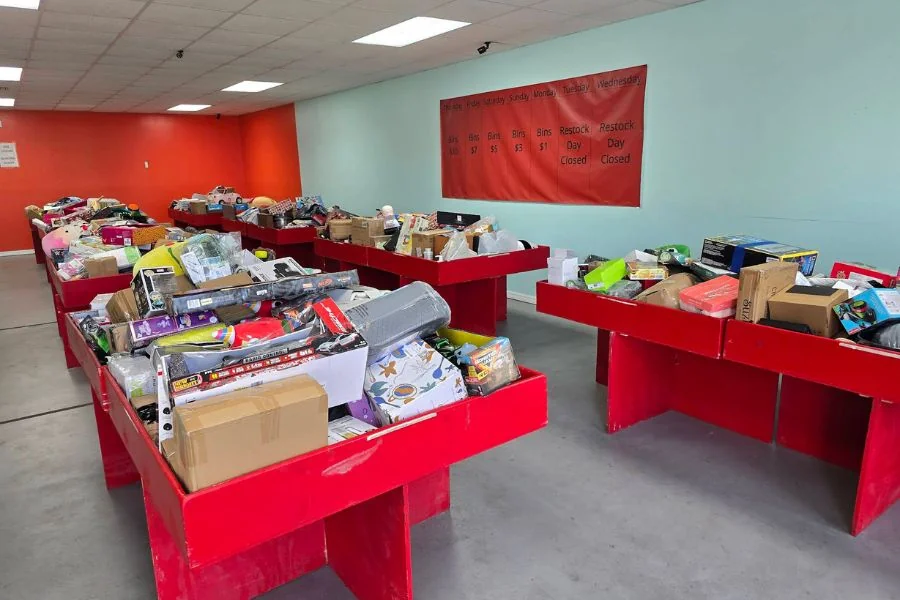Reselling has created many ways for people to earn extra money or even start a full-time business by flipping discounted products online. Bin stores are one of the easiest and most profitable places to begin, offering new or gently used items at much lower prices than retail.
If you’ve ever wondered how people turn $5 purchases into $50 sales, this step-by-step guide will walk you through how to source, evaluate, list, and sell bin store items online for real profit.
Understanding the Bin Store Reselling Model
Bin stores sell overstocked, returned, or liquidation items from major retailers like Amazon, Walmart, and Target. The key difference between these stores and traditional retailers is how they price and present products. Instead of individually labeling items, everything is dumped into large bins and sold at a flat rate that drops daily.
For example, items might cost $10 each on Friday, $5 on Sunday, and just $1 by Tuesday. Resellers look for high-value products during these cycles, aiming to flip them online for several times what they paid.
The low investment and high potential margins make bin store reselling one of the most accessible side hustles for beginners.
Step 1: Find Reliable Bin Stores Near You
Your first step is to locate nearby discount bin stores that consistently offer quality inventory. Search locally or join online reseller groups where people share restock schedules and reviews. The best stores restock weekly and are transparent about where their pallets come from.
For example, the Amazon bin store in Mississippi is popular with local resellers because it regularly stocks electronics, tools, and home goods. These categories usually sell quickly online.
When evaluating stores, look for these indicators of quality:
- Clean, organized layout
- Transparent restock days and pricing structure
- Staff who allow product testing or inspection before purchase
- Steady flow of new inventory each week
Once you’ve found a few dependable sources, mark their schedules on your calendar. Timing your visits right can make a huge difference in what you find.
Step 2: Learn How to Spot Profitable Items
Not every bargain is worth flipping. Successful resellers develop an eye for items that move quickly and yield good profit margins. Focus on categories with consistent online demand:
- Small electronics and accessories
- Home improvement tools
- Fitness and wellness gadgets
- Kitchen appliances and cookware
- Brand-name shoes and clothing
Bring your smartphone on every trip and use marketplace apps (like eBay or Mercari) to research “sold” listings. This tells you exactly how much an item has sold for recently, giving you confidence in your purchasing decisions.
If an item sells for at least three times its cost, it’s a solid candidate for resale.
Step 3: Check Product Condition Carefully
Since many bin store items are returns or overstocked products, their condition can vary. Always inspect your finds before checkout. Look for:
- Missing pieces or cords
- Damaged packaging (not a dealbreaker if the product is intact)
- Functionality: test when possible
- Product authenticity
Some items, like open-box electronics or small appliances, can be tested at home if the store does not have outlets. If an item is incomplete but still valuable, you can sell it for parts, since many buyers look for spare components online.
Step 4: Clean, Photograph, and Prepare Your Inventory
Presentation is key in online sales. After you bring your items home, clean them well and set them up for photos. Use a plain background and good lighting, such as natural light, to help your products look appealing and professional.
When taking pictures:
- Capture multiple angles, including close-ups of details or flaws.
- Include original packaging or accessories in the photo if available.
- Keep your images consistent to build trust with buyers.
The more transparent and visually appealing your listings are, the faster they’ll sell.
Step 5: Choose the Right Online Platforms
Different products perform better on different marketplaces. Here’s a quick breakdown:
- eBay: Great for electronics, collectibles, and niche items.
- Facebook Marketplace: Ideal for local sales and bulky products.
- Poshmark or Mercari: Perfect for clothing, shoes, and lifestyle items.
- Amazon (used section): Suitable for approved sellers with high-demand products.
Start with one or two platforms to get comfortable, then add more as you gain experience. Each marketplace has its own rules, fees, and buyer habits. Learning these details helps you price your items well and increase your profits.
Step 6: Write Honest and Persuasive Listings
A well-written listing can make the difference between an item selling in hours versus sitting for weeks. Use clear, keyword-rich titles and accurate descriptions that highlight both the product’s value and condition.
For example:
Good: “Instant Pot Duo 6-Quart Pressure Cooker – Like New, Tested and Working”
Better: “Instant Pot Duo 6QT Multi-Use Pressure Cooker – 7 Functions, Great Condition, Fast Shipping”
The second title uses keywords that buyers often search for. Always include details like brand, model, condition, and size, and be honest about any flaws. Being transparent helps buyers feel confident and reduces the chance of returns.
Step 7: Set Prices That Attract Buyers
Pricing requires a balance between competitiveness and profitability. Research what similar items have sold for recently, then aim for slightly below the average price to stand out.
Factor in:
- Platform fees (10–15% on most sites)
- Shipping costs
- Your desired profit margin
If an item does not sell after a few weeks, try lowering the price or offering free shipping. The sooner your items sell, the sooner you can buy new inventory.
Step 8: Manage Shipping and Customer Service
Efficient shipping is crucial for maintaining good reviews and repeat buyers. Use reliable carriers, invest in quality packaging, and print shipping labels directly from your selling platform to save time.
Respond to customer messages promptly and courteously. Even one negative experience can impact your reputation, while positive interactions can lead to referrals and loyal customers.
Using a professional tone and clear communication helps you build trust as a reseller.
Step 9: Track Your Profits and Scale Strategically
Treat your reselling operation like a business from day one. Keep records of:
- Purchases and costs per item
- Sale prices and fees
- Net profit margins
Once you understand which products bring the highest returns, scale strategically. That might mean sourcing from multiple bin stores, buying entire pallets, or focusing on a specific niche like tools, electronics, or apparel.
Many full-time resellers started small, refining their systems and reinvesting profits to grow consistently.
Step 10: Stay Consistent and Keep Learning
Success in flipping takes time and comes from being consistent, doing research, and staying flexible. Markets change, demand goes up and down, and new opportunities often come up. Stay involved in reseller groups, watch for trends, and keep trying new products to your experience.
Final Thoughts: Turning Bargains into Business
Flipping bin store items is more than just a side hustle. It is a modern way to start a business that uses creativity, resourcefulness, and strategy. With low startup costs, flexible hours, and many opportunities, it is one of the easiest ways to earn money online.
The key is simple: start small, stay consistent, and keep improving your process. With the right attitude, a few good items, and some effort, you can turn yesterday’s retail returns into tomorrow’s profit, one flip at a time.




